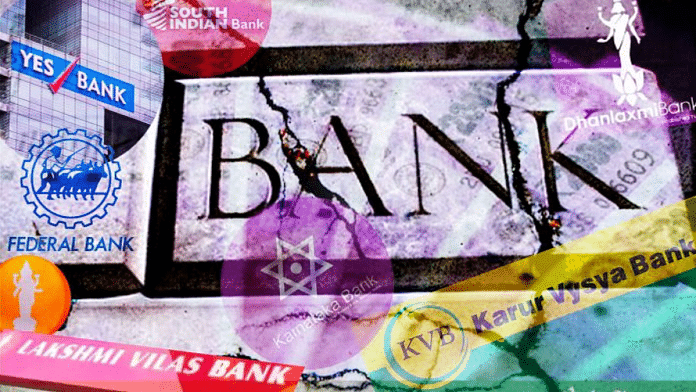Thank you dear subscribers, we are overwhelmed with your response.
Your Turn is a unique section from ThePrint featuring points of view from its subscribers. If you are a subscriber, have a point of view, please send it to us. If not, do subscribe here: https://theprint.in/subscribe/
In India, particularly in metro cities, private banks aggressively target employees of MNCs and blue-chip companies for their credit card and personal loan products, assuming they have a strong repayment capacity. Moreover, with consistent repayments, banks automatically increase credit limits and entice customers with further offers. While some individuals manage multiple cards responsibly and repay dues solely through their income, others may overspend, struggle with repayments, and resort to revolving credit—leading to defaults.
A similar trend has emerged in the corporate sector in recent years. Many start-ups and mid-sized company promoters have opted to dilute their shareholding to raise equity for business expansion. Various methods exist for securing equity, each requiring careful consideration of valuation.
In most cases, investment bankers advising these promoters suggest securing substantial valuations. In other instances, equity investors may directly approach financially as well fundamentally strong company’s promoters to inject funds under lenient terms. However, this approach can lead to financial distress at later stages.
Most Indian businesses are family-owned, established by their ancestors 30–40 years ago with conservative business practices. The younger generation, often enticed by equity investors promising high valuations, may seek external funding even when additional capital is unnecessary. This scenario mirrors private banks encouraging credit card holders to take on more cards despite a lack of genuine need.
Equity funding plays a crucial role in the growth and sustainability of startups and mid-cap companies in India. Valuation is necessary for equity transactions because it determines the fair price of shares and ensures transparency, compliance, and informed decision-making. If a business is generating solid revenues and profits, the valuation is real. If the valuation is purely based on projections and investor hype, it is mostly inflated. Valuation for equity funding in India today is a mix of both real and inflated (sometimes even fake), depending on the sector, investor sentiment, and the specific business in question.
Let us look at a few sectors in India where valuations have been both realistic and inflated/fake in recent years:
In Fintech (Inflated & Correcting) Example: Paytm
Many fintech startups raised massive valuations based on user growth and transactions rather than profitability. RBI has cracked down on non-compliant business models, and public market investors have rejected unrealistic valuations (e.g., Paytm’s stock collapse post-IPO). Present Status: Investors are now demanding unit economics and compliance before giving sky-high valuations.
Few examples from other Sectors/Industries
EdTech (Overvalued, Now Collapsing) BYJU’S, Unacademy, Vedantu
Valuations were based on aggressive student acquisition, deep discounting, and unrealistic expansion plans. Founders reported inflated revenues, losses were hidden through accounting tricks, and the “growth story” was exaggerated to raise billions. Now, BYJU’S valuation dropped from $22B to under $5B, layoffs happened, and investors are now unwilling to fund without profitability.
E-Commerce & Quick Commerce (Still Inflated but Stabilizing)
Flipkart, Zepto, Blinkit, Dunzo: Most companies run on deep discounts and high cash burn, yet they get unicorn valuations. Zepto got a $1.4B valuation despite heavy losses, and Blinkit was acquired by Zomato with uncertainty around its long-term profitability. Currently, some like Flipkart (Amazon competitor) have long-term viability, but quick commerce startups are under pressure to turn profitable.
SaaS & IT (More Realistic Valuations) Example: Freshworks, Zoho, Postman
These companies generate high revenue from global markets, have strong margins, and do not rely on discounts or hype. In these cases, valuations are market-driven, linked to actual revenues and profitability, making them more sustainable.
EV & New Energy (Mixed Bag – Some Real, Some Overhyped)
Example: Ola Electric, Ather, Tata Motors EV, Many EV startups raised big valuations without proven production capacity or after-sales service models. Ola Electric’s deliveries were delayed, but Tata Motors is backed by real market demand. Now, investors have become more cautious, focusing on production capabilities rather than just projections.
Let me focus on Indian Market Dynamics and its challenges:
India has witnessed significant growth in venture capital and private equity investments, driven by sectors like fintech, SaaS, and consumer tech. Initiatives like Startup India and tax incentives encourage equity funding. India’s IPO market is thriving, offering an exit route for early investors. On the other side the dilution of ownership, founders and promoters must give up equity, which may reduce control over decision-making. Longer Investment Horizon – Unlike debt, equity investors seek substantial returns over a longer period. Market Volatility – Mid-cap companies raising funds via IPOs are vulnerable to market fluctuations.
The Indian banking system’s lending practices differ from equity financing. Banks typically require both primary and collateral security for credit facilities, a practice accepted by both lenders and borrowers. Problems arise when businesses expand rapidly, bringing in additional lenders under consortium arrangements while offering the same security initially pledged. The consortium evaluates growth prospects based on past performance, industry trends, and market conditions, often extending credit on good faith due to the client’s formidable reputation. This, however, leads to a mismatch between security coverage and actual credit exposure.
The real issue emerges when clients face cash flow constraints and fail to meet commitments, resulting in accounts turning into NPAs (non-performing assets). In recent years, several commercial banks have encountered such precarious situations.
Conclusion:
Debt and equity raising are essential for business entrepreneurs. Success and sustainability depend on their ability to manage growth, scale efficiently, and compete in a dynamic market. While equity provides capital without collateral, debt financing from banks is secured against assets. Businesses must strike a balance between the two to achieve long-term strategic benefits, ensuring corporate governance and fair valuation for sustained success.
These pieces are being published as they have been received – they have not been edited/fact-checked by ThePrint.


